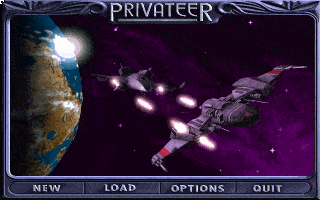
Roberts had built his reputation on cutting-edge games that pushed the state of the art in personal-computer technology to its absolute limit the first Wing Commander had been one of the first games to require an 80386 processor to run at all well, while Compaq had used Strike Commander as an advertisement for their latest Pentium-based computer models. Having been recently acquired by Electronic Arts, Origin felt keenly the need to prove themselves to their new owners by delivering an unequivocal, out-of-the-ballpark home run, and the third major iteration of their biggest franchise seemed as close to a guaranteed commercial winner as one could hope to find in the fickle world of computer gaming.
#Wing commander privateer review license
today calls a “small and inexperienced team”: “three main programmers with minimal game-dev experience, working cheap.” Their leader was one Frank Savage, an Origin-fan-turned-Origin-programmer so passionate about the Wing Commander franchise that his car bore the personalized license plate “WNGCMDR.” Had the group completed the game according to the original plan, it would likely have been released as yet another spinoff rather than the next numbered title in the series.Īs it was, though, the project was about to take on a whole new dimension: Chris Roberts stepped in to become the “director” of what was now to be Wing Commander III. The project was in the hands of what Robin Todd, a programmer on the project, Robin Todd was living as Chris Todd at the time, and is credited under that name in the game’s manual.
#Wing commander privateer review full
It was only when gamers proved less receptive to the change in milieu than Roberts and Origin had hoped that the former turned his full attention at last to Wing Commander III: Heart of the Tiger.Īt the time, the game that would eventually be released under that name was already in development, but the company’s ambitions for it were much smaller than they would soon become.

Having seen what their customers wanted, Origin doubled down on the drama in Wing Commander II, which was released in August of 1991 it told a much more elaborate and ambitious story of betrayal and redemption, complete with plenty of intrigue of both the political and the romantic stripe.Īfter that, the spinoffs and expansion packs had to carry the franchise’s water for quite some time, while Chris Roberts, its father and mastermind, brought its trademark approach to a near-future techno-thriller called Strike Commander, which was released after considerable delay in the spring of 1993. Upon its release in September of 1990, the first Wing Commander had taken the world by storm by combining spectacular graphics with a secret weapon whose potency surprised even Origin Systems, its Austin, Texas-based developer and publisher: a thin thread of story connected its missions together, being conveyed through the adventure-game style interface that was employed for the scenes taking place on the Tiger’s Claw, the outer-space “aircraft” carrier from which you and your fellow fighter pilots flew in a life-or-death struggle against the Kilrathi, a race of genocidal space cats who regarded humans the same way that Earthbound cats do mice. Prior to the release of DOOM in late 1993, Wing Commander I and II and their assorted spinoffs and expansion packs constituted not just the most popular collection of outer-space shoot-em-ups since the heyday of Elite but the most popular computer-gaming franchise of the new decade in any genre. If I weren’t doing one I’d be doing the other.


Movies and computer games are my two favorite things.


 0 kommentar(er)
0 kommentar(er)
